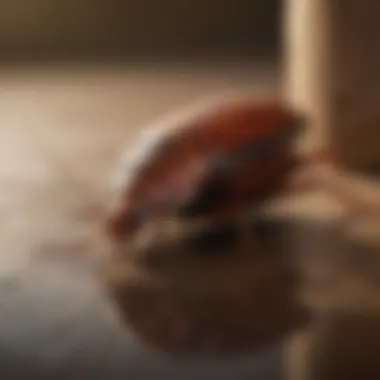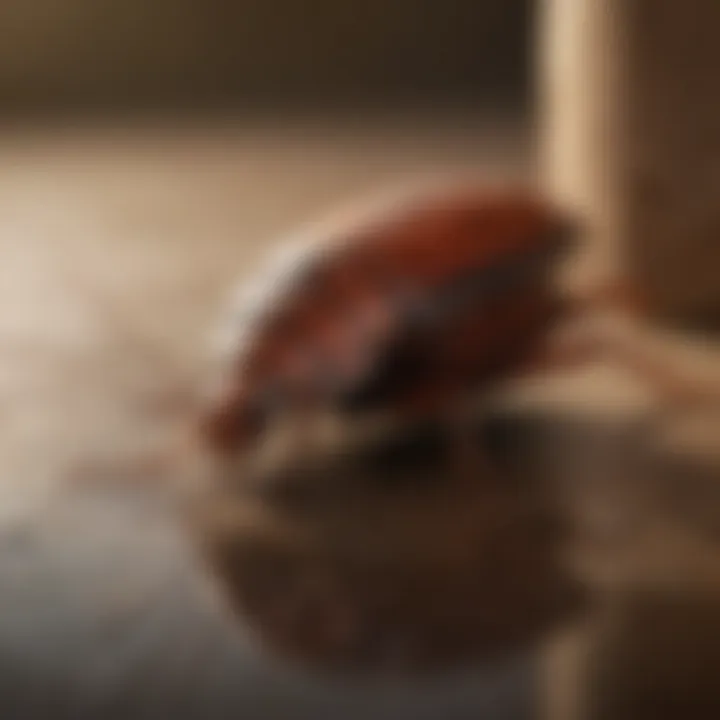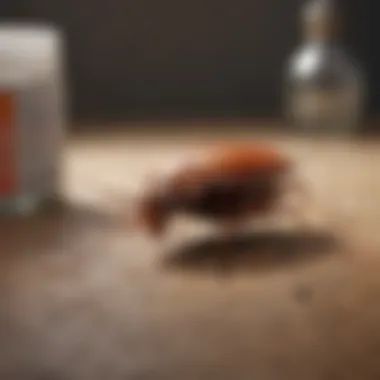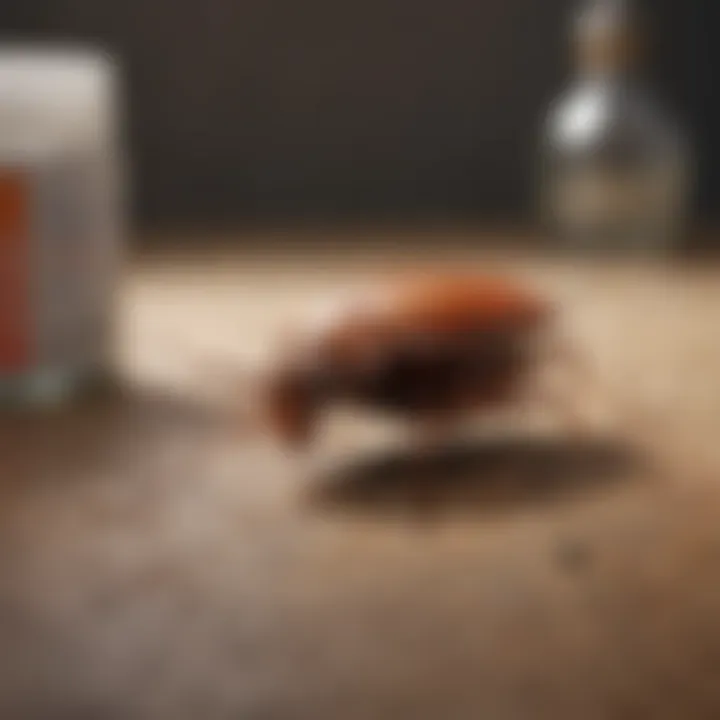Effective Cockroach Repellents: A Complete Guide


Intro
Cockroaches are infamous pests that can invade homes and apartments. Understanding how these creatures operate is essential for effective management and control. This comprehensive guide seeks to empower homeowners, renters, and pest control professionals to effectively repel and manage cockroach infestations. By analyzing both natural and chemical solutions, as well as various prevention and treatment strategies, this article provides the insights necessary to maintain a roach-free environment.
Pest Identification
Detailed descriptions of common pests
Cockroaches come in various species; however, the German cockroach, American cockroach, and Oriental cockroach are among the most common found in human habitats. The German cockroach is small, about 1.5 centimeters in length, with light brown color and two dark parallel stripes on its back. The American cockroach is larger, growing to about 4 centimeters and is reddish-brown. Finally, the Oriental cockroach appears black and is typically slightly shorter than the American species.
Signs and symptoms of infestations
Infestations can manifest in several ways. Homeowners should be vigilant for:
- Droppings that resemble coffee grounds or black pepper scattered around food sources or hiding places.
- An unpleasant, oily odor, which intensifies with larger populations.
- Egg cases that are brown or dark in color, usually found tucked away in hidden areas.
If you notice any of these signs, it is crucial to address the issue promptly to prevent further complications.
Prevention Strategies
Home maintenance tips for pest prevention
Preventing cockroaches is a proactive endeavour. Here are effective practices to consider:
- Seal entry points: Inspect doors, windows, and vents for gaps or cracks. Use caulk and weatherstripping as necessary.
- Maintain cleanliness: Regular cleaning of surfaces, especially in kitchens and dining areas, minimizes food sources that attract roaches.
- Dispose of waste: Keep garbage bins sealed, and take out the trash regularly to deter cockroach attraction.
Natural deterrents and barriers
Incorporating natural options can also assist in prevention. Consider employing:
- Boric acid: When sprinkled in corners and along baseboards, it can be a deterrent.
- Diatomaceous earth: This natural substance causes dehydration in roaches when they come into contact with it.
- Essential oils: Peppermint and tea tree oils can serve as natural repellents when mixed with water and sprayed around the home.
Treatment Options
Overview of chemical vs. natural treatments
When treating cockroaches, there are primarily two categories: chemical and natural treatments. Chemical treatments often offer immediate results but may involve toxins that are not suitable for all households. Natural treatments usually require patience but are safer for homes with pets and children.
Step-by-step guides for DIY treatments
Chemical treatment steps:
- Identify the affected areas.
- Apply a commercial cockroach pesticide, following the instructions on the product label.
- Allow the area to ventilate properly afterward.
Natural treatment steps:
- Mix a solution of equal parts boric acid and sugar in a bowl.
- Place this mixture in areas where cockroaches have been spotted, ensuring it is inaccessible to pets.
- Monitor the effectiveness and reapply as necessary.
"Effective pest management is often a blend of prevention and treatment strategies."
Consistent effort towards maintaining a clean environment and practicing effective pest management strategies can significantly reduce both existing cockroach populations and the likelihood of new infestations. This resource provides essential information tailored to meet the needs of homeowners, allowing for informed decisions in pest prevention and management.
Understanding Cockroach Behavior
Understanding cockroach behavior is essential in effectively addressing infestations. By comprehending their biology, habitat preferences, and reasons for their presence, homeowners can develop more effective strategies for prevention and control. This knowledge empowers individuals to take informed actions against these pests, reducing the likelihood of an infestation and the associated health risks.
Biology and Habitat
Cockroaches are resilient insects that thrive in various environments. There are over 4,000 species of cockroaches, but the most common types found in homes include the German cockroach, American cockroach, and Oriental cockroach. Each of these species exhibits unique traits and habitat preferences.
Typically, cockroaches prefer dark, warm, and moist environments. They can often be found in kitchens, bathrooms, and basements. Their biological structure allows them to hide in small crevices and nooks, making detection difficult. Their bodies are flat, enabling them to squeeze through tight spaces. They also have a rapid reproduction rate. A female German cockroach can produce up to 40 eggs at once, leading to rapid population growth if not controlled.
Cockroaches are not just pests; they are carriers of disease. Understanding their biology and habitats helps us understand how to effectively manage their presence.
Reasons for Infestation
Several factors contribute to cockroach infestations.
- Food Sources: Cockroaches are omnivores and will eat almost anything. They are particularly drawn to food residues, crumbs, and improperly stored food.
- Moisture: These insects require water to survive. Leaks or high humidity areas attract them.
- Shelter: Clutter and debris create ideal hiding spots for cockroaches. They often seek refuge in places that provide protection from light and disturbances.
- Seasonal Changes: During colder months, cockroaches may seek warmth indoors, increasing the likelihood of infestation.
By identifying the reasons behind cockroach infestations, individuals can take preventive steps to mitigate these factors and safeguard their homes from these unwanted pests.


The Importance of Effective Repellent
Effective repellents play a crucial role in managing and controlling cockroach populations in homes and businesses. Cockroaches are known for their resilience and ability to withstand various cleaning and sanitation methods. Their presence can lead to significant health risks and economic impacts, making it imperative to utilize effective repellents as a part of an overall pest management strategy.
Cockroach repellents come in various forms, including natural and chemical options. Understanding the benefits and considerations of these repellents is essential for homeowners and pest management professionals. Proper use of repellents contributes not only to immediate pest control efforts but also to long-term prevention. This guidance allows individuals to make informed decisions about which repellent may work best according to their specific circumstances.
Health Risks Associated with Cockroaches
The health risks posed by cockroaches are considerable. These pests are known carriers of numerous bacteria, pathogens, and allergens that can affect human health. Some of the key health concerns include:
- Allergic Reactions: Cockroach droppings, saliva, and body parts can trigger asthma and allergies in sensitive individuals.
- Disease Transmission: Cockroaches can spread diseases such as salmonella, E. coli, and other infections through contamination of food and surfaces.
- Respiratory Issues: Inhaling cockroach allergens may lead to respiratory problems, especially in children and individuals with pre-existing health conditions.
The impact of these health risks highlights the necessity of implementing effective repellents. By using appropriate measures to deter cockroaches from nesting and feeding in close proximity to living spaces, individuals reduce the chances of health-related complications.
Economic Impact of Infestations
Cockroach infestations can result in various economic disadvantages for homeowners and businesses. The following points illustrate the economic impacts:
- Property Damage: Cockroaches can cause damage to materials and structures. They may chew through insulation, fabric, and even electrical wiring.
- Business Reputation: For commercial establishments, the presence of cockroaches can harm the reputation of the business. It may lead to loss of customers and revenue.
- Increased Pest Control Costs: Neglecting an effective repellent strategy can result in higher expenses for pest control services in the future, as infestations become more severe over time.
"Prevention is often more economical than treatment. A thorough management strategy using effective repellent helps avoid future costs associated with extensive infestations."
In summary, effective repellents serve as a first line of defense against the health risks and economic burdens posed by cockroaches. Understanding both aspects will encourage proactive measures in pest management practices, ultimately leading to a healthier and more comfortable living environment.
Natural Repellents
Natural repellents offer a compelling alternative to chemical solutions in pest control. As concerns about toxins and their impact on health and the environment grow, many homeowners seek methods that are safer yet effective. Natural repellents are particularly appealing due to their availability and low cost. They often include substances that are readily found in household items, making them accessible.
Also, some natural repellents not only deter cockroaches but may also provide additional benefits, such as pleasant scents or disinfectant properties. However, it is crucial to consider their effectiveness and application methods to ensure optimal use.
Essential Oils
Essential oils are often used in pest control for their strong scents and insect-repelling properties. Each type of oil offers unique features that can contribute to cockroach management, making them a valuable option for those looking to utilize natural methods.
Peppermint Oil
Peppermint oil is renowned for its strong aroma, which cockroaches find highly unattractive. Its primary component, menthol, acts as a natural repellent, making it a beneficial choice in this context. This oil's refreshing scent can also enhance indoor air quality, adding to its appeal.
The main advantages of peppermint oil are that it is non-toxic and easy to apply. A disadvantage includes the need for regular reapplication, as the scent dissipates over time. Therefore, it may not provide long-lasting effects without frequent use.
Lavender Oil
Lavender oil possesses insect-repelling qualities alongside its well-known calming properties. The soothing scent can create a more pleasant home environment while simultaneously warding off cockroaches. Lavender's antimicrobial properties can benefit overall home hygiene as well.
A key characteristic of lavender oil is its versatility; it can be used in a diffuser or mixed with water for spray applications. However, like peppermint, it needs consistent reapplication to maintain its effectiveness in deterring cockroaches.
Tea Tree Oil
Tea tree oil stands out due to its potent antibacterial and antiseptic properties. It acts as a strong deterrent against cockroaches, making it an effective natural repellent. The unique feature of tea tree oil is its ability to combat germs and odor, enhancing its role in pest control.
One advantage of tea tree oil is that it is effective even in smaller quantities, making it economical. However, a downside is that its distinct scent may not be pleasant for everyone, which could limit its home usage.
Vinegar and Baking Soda
Vinegar and baking soda are two common household items known for their cleaning attributes which also serve as natural repellents for cockroaches. Vinegar, with its acetic acid, disrupts the sensory receptors of cockroaches, while baking soda creates an inhospitable environment for them. Together, they can be combined into a solution and used in areas frequented by these pests.
Diatomaceous Earth
Diatomaceous earth is a natural powder composed of crushed fossilized algae. It acts as a physical barrier for cockroaches. When they crawl over it, the tiny particles penetrate their exoskeleton, leading to dehydration and eventual death. This non-toxic method effectively targets the pest lifecycle, making it suitable for both prevention and eradication efforts. Additionally, it is safe for humans and pets when applied as directed, further enhancing its usability as a natural repellent.
By utilizing these natural repellents wisely, homeowners can create a pest-free environment without resorting to harsh chemicals. It’s essential to understand each method’s application and limitations for optimal results.
Chemical Repellents
Chemical repellents play a crucial role in the combat against cockroach infestations. They offer powerful solutions that can quickly reduce aggressive populations. While natural options have their place, chemical repellents often provide a level of efficiency that can be indispensable for serious infestations. In environments where cockroaches pose significant health risks, these repellents can act as a frontline defense, allowing for rapid intervention. It is important to understand their components and application techniques to ensure both effectiveness and safety.
Overview of Chemical Options
Chemical repellents come in various forms, each designed for specific circumstances. These include sprays, baits, and dusts. Each method carries its own advantages, but all are designed to disrupt the cockroach's ability to thrive. For homes with severe infestations, chemical options might be the most viable solution. The effectiveness often comes down to selecting the right product based on the specific needs of the environment and the severity of the infestation.
Common Ingredients in Cockroach Repellents


A few ingredients frequently appear in effective cockroach repellents. Understanding these components can guide homeowners in making informed choices.
Pyrethrins
Pyrethrins are derived from chrysanthemum flowers. They work by attacking the nervous system of cockroaches. This ingredient is highly popular due to its fast-acting capability. One key characteristic of Pyrethrins is that they are effective in small doses. This not only makes them efficient but also minimizes potential harm to humans and pets. However, they can break down quickly when exposed to sunlight, which may limit their effectiveness outdoors.
"Pyrethrins offer an environmentally friendly option that still delivers solid results in pest control."
Imidacloprid
Imidacloprid is a systemic insecticide that disrupts the transmission of nerve impulses in insects. This chemical can provide long-term control of cockroaches. Its ability to spread through baits makes it a practical option for reaching hidden infestations. The use of Imidacloprid is popular among pest control professionals as it has proven to be effective against several species of cockroaches. However, its prolonged use can lead to resistance among cockroach populations, necessitating careful management in its application.
Boric Acid
Boric Acid functions as a slow-acting poison that targets cockroaches when ingested. It is not immediately lethal; however, it effectively disrupts the digestive system of the insect, leading to eventual death. This characteristic makes Boric Acid a favored option among those looking for a more gradual solution. It is also easy to apply in corners and crevices, making it suitable for targeting hidden cockroach habitats. However, care should be taken with application to avoid pellets lying readily accessible to pets and children.
Understanding these ingredients helps homeowners choose the appropriate product for their needs. Each ingredient brings unique benefits and considerations, which can significantly impact the effectiveness of the overall pest control strategy.
Application Methods
Application methods play a critical role in effectively managing cockroach infestations. The way repellents are applied can greatly impact their effectiveness and overall pest control strategy. Each method has its own unique benefits and considerations, enabling users to select the most suitable choice for their specific circumstances. Understanding how to apply these products correctly is essential for maximizing their efficacy and ensuring a pest-free environment.
Sprays
Sprays are among the most direct ways to combat cockroach presence. They offer the advantage of immediate action. Most sprays include active ingredients that attack cockroaches on contact. It is important to select products labeled specifically for cockroach control. When using sprays, following the manufacturer's instructions is vital to ensure safety and effectiveness.
Consider using sprays in areas where cockroaches are likely to hide, such as behind appliances, in cracks, and beneath sinks. The elements in these sprays create a barrier that can deter further entry and infestation. However, homeowners should keep in mind that sprays may need to be reapplied periodically, especially after cleaning or exposure to moisture.
Baits and Traps
Cockroach baits and traps are another effective modality for controlling infestations. Baits typically contain food that attracts cockroaches, combined with an insecticide. The cockroach consumes the bait and returns to its nest, where it can affect other roaches. This method has a dual action; it not only reduces the population but also minimizes the chances of chemical exposure to humans and pets compared to sprays.
Traps, on the other hand, are designed to capture the insects. These include sticky traps and mechanical traps. Sticky traps capture cockroaches physically, allowing for monitoring and helping to gauge the extent of an infestation. Bait stations are easier to place discreetly in various locations, which can help to draw cockroaches away from living areas.
Dusts and Powders
Dusts and powders serve as excellent options for reaching places that other forms may not access. The fine particles can settle in cracks, crevices, and other hidden areas where cockroaches are known to dwell. When the cockroaches come in contact with the dust, it clings to their bodies, leading to ingestion or inhalation. This process can be particularly effective in the long-term reduction of cockroach populations.
While using dusts, caution is advised. Apply them in moderation to prevent excess buildup, which can be detrimental. It is crucial to select products that are labeled specifically for indoor use and follow safety guidelines to protect children and pets.
"The key to effective treatment lies not only in the choice of repellent but also in its application method. Each method has nuances that can affect its overall performance."
Comparative Effectiveness
The comparative effectiveness of cockroach repellents encompasses a vital exploration of how various solutions—both natural and chemical—perform against these pests. Understanding this aspect is crucial for homeowners and pest management professionals alike, as it informs decisions on which methods to adopt based on effectiveness, safety, and long-term results.
Natural vs. Chemical
When evaluating natural versus chemical repellents, it is essential to consider their respective mechanisms and ingredients. Natural repellents, such as essential oils or vinegar, may appeal to those who prefer eco-friendly solutions. They tend to have fewer health risks associated with them and can be safer for families and pets. However, their effectiveness can vary greatly, often necessitating more frequent application than their chemical counterparts.
Chemical repellents, on the other hand, usually provide immediate and more potent action. Ingredients like Pyrethrins and Imidacloprid can effectively kill cockroaches upon contact or ingestion, making them a preferred choice for severe infestations. That said, these substances may pose health risks if not used properly, requiring careful adherence to instructions.
Ultimately, the decision between natural and chemical methods should weigh factors such as effectiveness, safety, and personal preferences. For instance, a homeowner might use natural options for minor issues, but switch to stronger chemical repellents for significant infestations.
Long-term Effectiveness
Long-term effectiveness of cockroach repellents plays a substantial role in pest control strategies. Natural repellents may require consistent application and may not provide lasting protection. While they help in repelling cockroaches effectively in the short term, they may not fully eradicate an infestation. Regular use is essential, which can increase overhead costs and labor.
Conversely, chemical repellents often have residual effects that can last for weeks or even months. These products create a barrier that deters cockroaches from entering specific areas. However, it's critical to understand that the development of resistance among cockroach populations can diminish these long-term benefits. Over-reliance on the same chemical compounds can lead to decreased efficacy.
Preventive Measures
Preventive measures are paramount in the fight against cockroach infestations. By implementing a series of targeted strategies, one can significantly reduce the risk of encountering these pests in the first place. Understanding the intricacies of preventive measures allows homeowners to maintain a comfortable living environment free from unwelcome insects. Key elements include maintaining cleanliness, sealing entry points, and carrying out regular inspections.
Keeping a Clean Environment
A clean environment is the foundation of effective pest control. Cockroaches thrive in places where food particles and waste accumulate. Thus, maintaining a tidy living space can deter them from settling in your home. Here are some steps you can take:
- Regular Cleaning: Sweep and mop floors often, particularly in the kitchen and dining areas.
- Food Storage: Store food in sealed containers to eliminate easy access for cockroaches. Always clean up spills and crumbs promptly.
- Waste Management: Dispose of garbage regularly. Using bins with tight lids also helps keep pests at bay.
- Decluttering: Reducing clutter, especially in dark and damp areas, minimizes hiding spots for cockroaches.
By consistent application of these cleaning practices, the potential for an infestation can be notably decreased.


Sealing Entry Points
Cockroaches are agile and can enter through the smallest of openings. Sealing entry points is a critical step in preventive measures. Identifying and blocking potential entryways is vital. Consider the following tips:
- Inspect Gaps: Examine door frames, windows, and even utility entries for gaps.
- Use Caulk and Weather Stripping: Applying caulk to cracks and installing weather stripping can help seal openings.
- Screen Vents: Adding screens to ventilation shafts keeps pests out while allowing air circulation.
By effectively sealing these entry points, the likelihood of cockroaches entering your home decreases significantly.
Regular Inspections
Routine inspections allow homeowners to catch potential issues early on. A proactive approach to checking for signs of cockroach activity saves time and resources down the line. You can follow these inspection practices:
- Look for Signs: Keep an eye out for droppings, shed skins, egg cases, or the bugs themselves.
- Inspect Popular Hiding Spots: Areas like behind appliances, under sinks, and in dark corners are common shelter locations for cockroaches.
- Consider Professional Assessments: Engaging pest control services for comprehensive inspections can provide deeper insights into potential vulnerabilities.
In summary, preventive measures form a robust defense against cockroach infestations. By keeping a clean environment, sealing entry points, and conducting regular inspections, homeowners can significantly reduce the risk of these pests.
Myths and Misconceptions
Understanding the myths and misconceptions surrounding cockroaches and their management is crucial for homeowners. Many people hold onto beliefs that might not be based on scientific evidence. This section aims to clarify common misunderstandings, dispel myths, and provide facts that empower effective pest control. By addressing these misconceptions, homeowners can make more informed choices regarding cockroach repellent methods and strategies, improving their ability to maintain a pest-free environment.
Common Beliefs About Cockroaches
Several prevalent ideas about cockroaches exist in public consciousness. One common belief is that cockroaches can survive without food for an extended period. While it’s true that cockroaches can survive without food for weeks, they ultimately require sustenance. Another myth is that hiring pest control is unnecessary if a home is kept clean. Though cleanliness is a significant factor, it does not completely prevent infestations. Cockroaches can enter homes through tiny cracks or hitch rides on bags and boxes.
Moreover, there is a notion that all cockroach repellents are effective. This is misleading, as not all repellents work similarly. Some might repel certain species but not others. It is essential to recognize these nuances in order to choose the right products for your specific situation.
Debunking Misleading Strategies
Many homeowners resort to gimmicky tactics to combat cockroaches. For example, some people believe that using basic household items, like baking powder, can annihilate cockroaches effectively. Unfortunately, this is not true. While these items may have some effect in small quantities, they lack the potency of specific commercial repellents designed for pest control.
Another common strategy involves using essential oils. While certain oils can mask odors, they do not reliably repel cockroaches or eliminate infestations. Such methods might provide some short-term relief but often fail to address the root of the problem. Homeowners might feel a temporary sense of security, but ultimately, they must embrace comprehensive strategies for long-term pest control.
The real challenge is not just about repelling cockroaches, but understanding their behavior and implementing effective measures to prevent their return.
It is crucial to sort fact from fiction when discussing cockroach management. Relying on misinformation can lead to ineffective tactics, wasted resources, and ongoing infestations. Therefore, homeowners should deepen their understanding of effective repellents and pest management strategies to contain these unwelcome guests.
Professional Pest Control Services
Professional pest control services are often necessary when dealing with severe cockroach infestations. These experts bring specialized knowledge and tools that homeowners often lack. Relying on professionals can save you time and effort while providing effective results.
Moreover, these services provide a sustainable approach to cockroach management. Rather than only addressing the symptoms, professionals analyze the underlying issues. They can identify the sources of infestation and recommend a combination of treatments tailored to your specific situation.
When to Seek Professional Help
It is critical to recognize when a cockroach problem exceeds your capacity to manage it. Here are some situations indicating that you may need professional help:
- Persistent Infestation: If cockroaches remain despite your best efforts, it’s time to call for assistance.
- Health Concerns: Cockroaches may carry harmful bacteria. If you are concerned about health risks, a professional can help mitigate these threats.
- Unidentified Species: Some cockroach species are more challenging to control than others. Identification by a professional can ensure the correct treatment.
- Extensive Damage: If you notice damage to your property or belongings, it could indicate significant infestation, necessitating expert intervention.
It is wise to assess your home diligently. If simple remedies like traps and sprays fall short, do not hesitate to seek professional help. The investment may save you larger costs in repairs and health issues later on.
What to Expect from Services
When engaging a pest control service, you can anticipate a thorough procedure that may include several steps:
- Inspection: Technicians will conduct a detailed inspection of your property. They will look for signs of cockroach activity, hiding spots, and possible entry points.
- Customized Treatment Plan: Based on their findings, they will devise a treatment plan fitting your infestation severity. This could involve chemical or natural methods.
- Implementation of Treatment: Trained professionals will execute the treatment, ensuring safety for your family and pets.
- Follow-up Services: Many pest control companies offer follow-up visits to assess the results and make necessary adjustments to the plan.
Professional pest control services often provide warranties or guarantees, ensuring the effectiveness of their treatments.
Ending
Understanding the best practices surrounding cockroach repellents is crucial for effective pest control. This article has provided an in-depth exploration of various methods and strategies to eliminate these unwanted insects. By recognizing their behavior and habitat, one can better assess and manage an infestation.
Utilizing both natural and chemical repellents forms the backbone of a robust pest management strategy. Natural options, such as essential oils and diatomaceous earth, provide a less toxic approach to repelling cockroaches. Conversely, chemical solutions like pyrethrins offer rapid action against these pests, making them suitable for immediate relief. Selecting the right method involves careful consideration of the environment and the specific needs of the household.
"A multi-faceted approach is key to maintaining a cockroach-free home."
In addition to repellents, preventive measures can't be overlooked. Keeping a clean environment, sealing entry points, and conducting regular inspections are fundamental in creating a barrier against potential infestations.
Recap of Best Practices
- Choose the Right Repellents: Identify whether natural or chemical solutions are best for your situation. Each has its strengths.
- Implement Preventive Strategies: This includes thorough cleaning, sealing cracks, and eliminating food sources.
- Regular Monitoring: Keep an eye out for signs of cockroach activity to catch infestations early.
- Consider Professional Help: If infestations persist despite your efforts, professional pest control may be necessary.
Final Thoughts on Repellents
The quest for the right cockroach repellent involves more than just selecting a product; it requires a comprehensive understanding of the problem. Each household is unique, which makes tailoring the solution critical.
As you evaluate your options, remember that consistency is key. Regular maintenance of cleanliness and careful inspections can significantly reduce the chances of encountering cockroaches. The right knowledge, combined with effective products and practices, will empower you in your pursuit of a pest-free environment.



